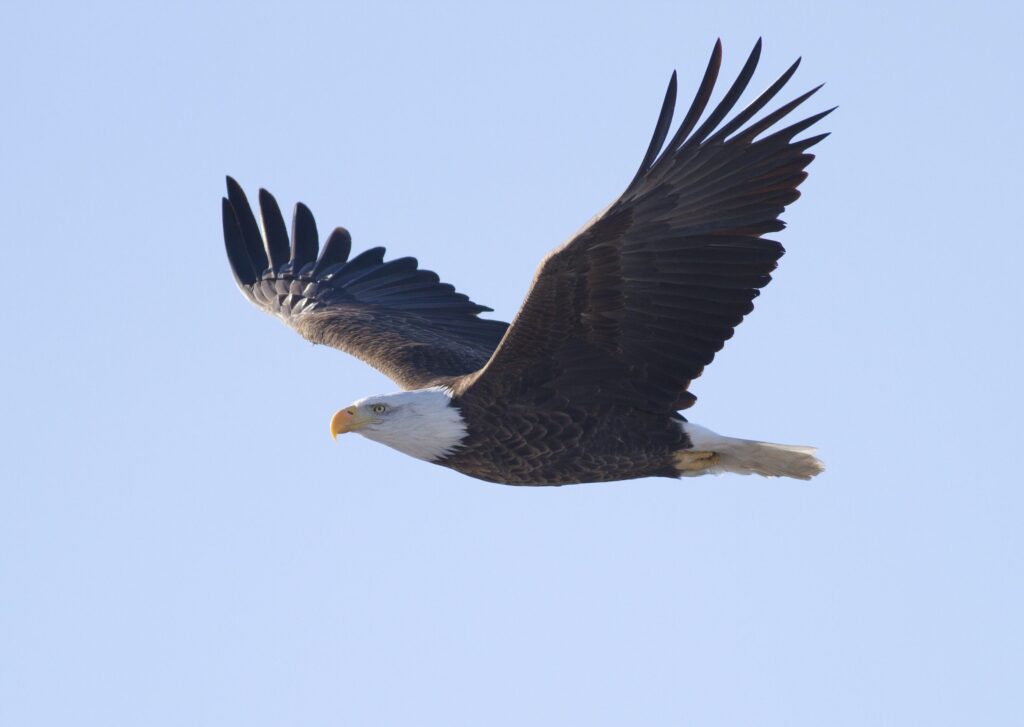The Bald Eagle (Haliaeetus leucocephalus) is a powerful and majestic bird of prey, widely recognized as the national symbol of the United States. Visit our Elm Creek Backyard exhibit to witness these awe-inspiring raptors up close. Let’s explore their diet, habitat, size, and conservation status, as well as some fascinating facts that make the Bald Eagle a truly iconic species.

Diet
Bald Eagles are primarily piscivorous, meaning that their diet consists mainly of fish. They are opportunistic feeders, also preying on birds, reptiles, amphibians, and small mammals when fish are scarce. Bald Eagles are skilled hunters, using their exceptional eyesight and powerful talons to snatch prey from the water or the ground.
Habitat
Bald Eagles inhabit a variety of aquatic environments, including lakes, rivers, marshes, and coastal areas, throughout North America. They can be found from Alaska and Canada to the Gulf of Mexico, and from the Pacific to the Atlantic coasts. Bald Eagles prefer habitats with tall trees or cliffs for nesting and perching, as well as access to abundant food sources.
Size and Weight
Bald Eagles are large birds of prey, with a wingspan ranging from 6 to 7.5 feet (1.8 to 2.3 meters). Their body length typically measures between 28 to 40 inches (71 to 102 cm), and they weigh between 6.5 to 14 pounds (3 to 6.3 kg). Females are generally larger and heavier than males.
Conservation Status
The Bald Eagle is currently listed as “Least Concern” on the International Union for Conservation of Nature (IUCN) Red List. After facing severe declines due to habitat loss, persecution, and pesticide exposure in the mid-20th century, the Bald Eagle has made a remarkable recovery, thanks to rigorous conservation efforts and the banning of harmful pesticides like DDT.
Fascinating Facts
National Symbol:
The Bald Eagle was chosen as the national emblem of the United States in 1782, symbolizing strength, freedom, and courage.
Bald by Name, Not by Nature:
The name "Bald Eagle" comes from the Old English word "balde," meaning white, referring to the bird's distinctive white head and tail feathers. Adult Bald Eagles develop this striking plumage at around 4-5 years of age.
Incredible Eyesight:
Bald Eagles have exceptional eyesight, estimated to be 4 to 8 times sharper than that of humans. This keen vision allows them to spot prey from great distances while soaring high above the ground or perched in a tree.
Monogamous Mates:
Bald Eagles form long-lasting, monogamous pair bonds, often returning to the same nesting territory year after year. Together, they build massive nests in tall trees or on cliff ledges, with some nests weighing over a ton and measuring up to 9 feet (2.7 meters) in diameter.
Longevity:
Bald Eagles are known to live for up to 28 years in the wild, although their average lifespan is around 15 to 20 years. In captivity, they can live even longer, with some individuals reaching over 40 years of age.
Visit the Bald Eagle at the Abilene Zoo
During your visit to the Abilene Zoo, be sure to stop by our Elm Creek Backyard exhibit to observe the magnificent Bald Eagle. By learning about their unique adaptations, hunting prowess, and the important role they play in the ecosystem, you’ll gain a newfound appreciation for this bird of prey
FAQ
Are bald eagles still endangered?
No. Bald eagles are no longer endangered. The species made remarkable population recoveries thanks to rigorous conservation efforts and the banning of harmful pesticides like DDT that had contributed to their decline. They’re currently classified as “Least Concern” on the International Union for Conservation of Nature (IUCN) Red List, and are still protected under the Migratory Bird Treaty Act and the Bald and Golden Eagle Protection Act.
Do bald eagles migrate?
Yes. Bald eagles migrate partially in response to food and water resource needs. The species can occupy a territory with abundant nourishment year-round, but many will migrate south or to the coasts in the winter in search of food.
What does the bald eagle represent?
The Bald eagle represents strength, courage, freedom, and immortality, powerful values that qualified it as the national bird of the United States.
